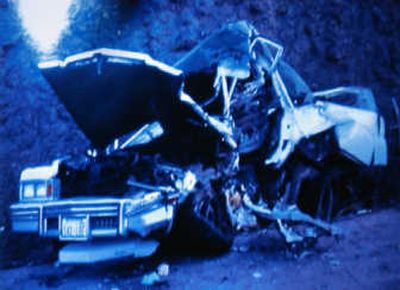Detective calls crash ‘horrific’

The June 2001 wreck that killed three Washington State University students and severely injured several others left a beefy 1970s Cadillac looking like an “accordion,” in the words of one attorney in the case Friday.
One Washington State Patrol detective, Ron Snowden, said he’d never seen a car so damaged “other than having a train or a semi involved.”
“To me it was quite horrific, a huge amount of contact damage,” said David Feen, the patrol’s lead detective on the investigation that night. The driver’s side of the Cadillac – packed with seven WSU students – was “ripped open,” he said.
Friday marked the 10th day in the three- to four-week trial of former WSU student Fred Russell, who’s charged with three counts each of vehicular homicide and vehicular assault. The trial, which started slowly last week, is now moving faster than either side anticipated. Closing statements could come as soon as Thursday.
Russell was allegedly drunk, speeding and passing in a no-passing zone on the Moscow-Pullman highway, a couple of miles west of the Idaho line . After years of news coverage, the trial was moved from Whitman County to Cowlitz County to find an impartial jury.
On Friday, prosecutors painstakingly reconstructed the crash, using State Patrol experts and photos taken of the 330-foot, four-car crash scene. According to the investigators, Russell’s Blazer was about 3 1/2 feet over the centerline when it sideswiped an oncoming green Geo, snapping off the axle and driving one of the Geo’s front tires back into the firewall. Russell’s Blazer then slammed into the 1978 Cadillac, sending it backward into a rock wall beside the roadway, before striking a red Geo. In some photographs, the Cadillac looks like crumpled paper. The Blazer and the red Geo burned. Both the Blazer and Cadillac remain in the State Patrol impound yard in Spokane as evidence, six years after the crash.
Fenn said Friday that he couldn’t calculate how fast Russell was driving, since the first impact was a sideswipe. But given the damage to all the vehicles, he said, “it looked to me like he was well over the posted speed limit.”
Prosecutors called a long string of witnesses, crash victims, firefighters, medical personnel and police during the week. The room is increasingly crowded with relatives of the students killed or injured in the crash, as well as Russell’s mother and aunt.
On Thursday, defense attorney Francisco Duarte sharply questioned Robert Hart, who told police that he pulled over to let a speeding Russell go by seconds before the accident. In opening statements and again Thursday, Duarte questioned why Hart left the crash scene, drove to his job as a night auditor at a Moscow motel and waited more than an hour before calling police.
Hart, who was driving a Subaru Brat, told police that Russell’s Blazer was driving “erratically” at an estimated 90 mph and flashing its lights at him to pass.
But Duarte suggested that Hart quickly pulled back onto the roadway, a move that would have forced Russell over the centerline into the oncoming lane. Hart immediately denied that.
A day earlier, a liquor store clerk testified that she sold Russell a half-gallon of vodka the night of the crash. A woman at a party he brought it to testified that seven people emptied the bottle, after which Russell went to a bar for what the bartender has said was one or two beers. A hospital blood test the night of the crash indicated Russell’s blood alcohol to be 0.128, or more than 1 1/2 times the 0.08 legal limit for driving.
Russell’s three lawyers have tried to poke holes in the state’s case, grilling investigators and witnesses on inconsistencies, like motorist Jill Baird’s recollection that she saw approaching rooftop running lights in the seconds before the car in front of her was struck and spun out. Investigators noted no visor lights on Russell’s vehicle, although Fenn noted that the fiberglass back half of the cab burned away in the fire.
The defense team maintains that the wrecks were a tragic accident, not a crime. On Friday, attorney Diego Vargas closely questioned a State Patrol investigator about how much worse the Cadillac damage was because it slammed backward into a rock wall after being struck in the driver’s side door by Russell’s Blazer. Two of the dead students – one of whom was partly ejected out the rear window – were sitting in the back seat.
Some family members were unhappy at that.
“Blaming the rock wall in the crash is like blaming gravity for the collapse of the World Trade Centers,” said Rich Morrow, whose daughter Stacy died in the wreck. “(Vargas) is grasping at straws.”
The Associated Press contributed to this report.